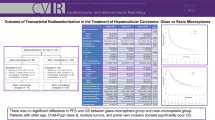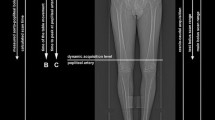Abstract
Objectives
To investigate whether the addition of nitroglycerine to transcatheter arterial (chemo)embolization (TAE/TACE) can increase the delivery and effectiveness of TAE/TACE in patients with hepatocellular carcinoma (HCC) by dual-energy CT.
Methods
HCC patients (BCLC stage A or B) were randomized to (n = 51) or not to (n = 50) receive nitroglycerine and an emulsion of Lipiodol with or without doxorubicin, followed by embolization with Gelfoam pledgets. Dual-energy CT was performed pre- and 1 to 3 months post-embolization to assess changes in tumour diameter and Lipiodol levels in tumours.
Results
Median tumour diameter decreased from baseline in both groups with and without nitroglycerine (7.11 % vs. 12.5 %, respectively), and was statistically significant in the group receiving nitroglycerine (P = 0.023). There was no difference between the two groups in disease response (P = 0.237). The concentration and percentage of Lipiodol retained in tumours were significantly greater in patients treated with nitroglycerine compared to those without (median concentration 15.05 mg/mL vs. 4.40 mg/mL, respectively, P < 0.001; median percentage 82.01 % vs. 36.75 %, respectively, P < 0.001).
Conclusions
Nitroglycerine increased delivery of the Lipiodol emulsion via TAE/TACE to HCC tumours with significant tumour reduction. Dual-energy CT can accurately quantify the amount of Lipiodol deposited in tumours.
Key Points
• Nitroglycerine improves delivery of tumour-targeted therapy via enhanced permeability and retention.
• In hepatocellular carcinoma, nitroglycerine added to TAE/TACE showed greater tumour reduction.
• Dual-energy CT can reliably quantify the amount of Lipiodol in TAE/TACE.



Similar content being viewed by others
References
Bosch FX, Ribes J, Díaz M, Cléries R (2004) Primary liver cancer: worldwide incidence and trends. Gastroenterology 127:S5–S16
Thomas MB, Jaffe D, Choti MM et al (2010) Hepatocellular carcinoma: consensus recommendations of the National Cancer Institute Clinical Trials Planning Meeting. J Clin Oncol 28:3994–4005
National Cancer Institute (2011) Adult primary liver cancer treatment (PDQ®) health profession version. http://www.cancer.gov/cancertopics/types/liver. Accessed 5 Nov 2011
Rougier P, Mitry, Barbare JC, Taieb J (2007) Hepatocellular carcinoma (HCC): an update. Semin Oncol 34:S12–S20
Ramsey DE, Kernagis LY, Soulen MC, Geschwind JF (2002) Chemoembolization of hepatocellular carcinoma. J Vasc Interv Radiol 13:S211–S221
Lencioni R (2010) Loco-regional treatment of hepatocellular carcinoma in the era of molecular targeted therapies. Oncology 78:107–112
Konno T, Maeda H, Iwai K et al (1983) Effect of arterial administration of high-molecular-weight anticancer agent SMANCS with lipid lymphographic agent on hepatoma: a preliminary report. Eur J Cancer Clin Oncol 19:1053–1065
Konno T, Maeda H, Iwai K et al (1984) Selective targeting of anti-cancer drug and simultaneous image enhancement in solid tumors by arterially administered lipid contrast medium. Cancer 54:2367–2374
Jinno K, Moriwaki S, Tanada M et al (1992) Clinicopathological study on combination therapy consisting of arterial infusion of lipiodol-dissolved SMANCS and transcatheter arterial embolization for hepatocellular carcinoma. Cancer Chemother Pharmacol 31:S7–S12
Matsumura Y, Maeda H (1986) A new concept for macromolecular therapeutics in cancer chemotherapy: mechanism of tumoritropic accumulation of proteins and the antitumor agent smancs. Cancer Res 46:6387–6392
Maeda H, Sawa T, Konno T (2001) Mechanism of tumor-targeted delivery of macromolecular drugs, including the EPR effect in solid tumor and clinical overview of the prototype polymeric drug SMANCS. J Control Release 74:47–61
Maeda H (2001) SMANCS and polymer-conjugated macromolecular drugs: advantages in cancer chemotherapy. Adv Drug Deliv Rev 46:169–185
Nagamitsu A, Greish K, Maeda H (2009) Elevating blood pressure as a strategy to increase tumor-targeted delivery of macromolecular drug SMANCS: cases of advanced solid tumors. Jpn J Clin Oncol 9:756–766
Maeda H, Noguchi Y, Sato K, Akaike T (1994) Enhanced vascular permeability in solid tumor is mediated by nitric oxide and inhibited by both new nitric oxide scavenger and nitric oxide synthase inhibitor. Jpn J Cancer Res 85:331–334
Wu J, Akaike T, Maeda H (1998) Modulation of enhanced vascular permeability in tumors by a bradykinin antagonist, a cyclooxygenase inhibitor, and a nitric oxide scavenger. Cancer Res 58:159–165
Seki T, Fang J, Maeda H (2009) Enhanced delivery of macromolecular antitumor drugs to tumors by nitroglycerin application. Cancer Sci 100:2426–2430
Stoeckelhuber BM, Suttmann I, Stoeckelhuber M, Kueffer G (2003) Comparison of the vasodilating effect of nitroglycerin, verapamil, and tolazoline in hand angiography. J Vasc Interv Radiol 14:749–754
Bilbao R, Bustos M, Alzuguren P, Pajares et al (2000) A blood-tumor barrier limits gene transfer to experimental liver cancer: the effect of vasoactive compounds. Gene Ther 7:1824–1832
Fang J, Nakamura H, Maeda H (2011) The EPR effect: unique features of tumor blood vessels for drug delivery, factors involved, and limitations and augmentation of the effect. Adv Drug Deliv Rev 63:136–151
Pleguezuelo M, Marelli L, Misseri M et al (2008) TACE versus TAE as therapy for hepatocellular carcinoma. Expert Rev Anticancer Ther 8:1623–1641
Graser A, Johnson TR, Chandarana H, Macari M (2009) Dual energy CT: preliminary observations and potential clinical applications in the abdomen. Eur Radiol 19:13–23
Zhang LJ, Peng J, Wu SY et al (2010) Liver virtual non-enhanced CT with dual-source, dual-energy CT: a preliminary study. Eur Radiol 20:2257–2264
Oliveri RS, Wetterslev J, Gluud C (2011) Transarterial (chemo)embolisation for unresectable hepatocellular carcinoma. Cochrane Database Syst Rev 16:CD004787
Marelli L, Stigliano R, Triantos C et al (2007) Transarterial therapy for hepatocellular carcinoma: which technique is more effective? A systematic review of cohort and randomized studies. Cardiovasc Intervent Radiol 30:6–25
Marelli L, Shusang V, Buscombe JR et al (2009) Transarterial injection of (131)I-lipiodol, compared with chemoembolization, in the treatment of unresectable hepatocellular cancer. J Nucl Med 50:871–877
Hou YC, Janczuk A, Wang PG (1999) Current trends in the development of nitric oxide donors. Curr Pharm Des 5:417–441
Author information
Authors and Affiliations
Corresponding author
Rights and permissions
About this article
Cite this article
Liu, YS., Chuang, MT., Tsai, YS. et al. Nitroglycerine use in transcatheter arterial (chemo)embolization in patients with hepatocellular carcinoma and dual-energy CT assessment of Lipiodol retention. Eur Radiol 22, 2193–2200 (2012). https://doi.org/10.1007/s00330-012-2484-4
Received:
Revised:
Accepted:
Published:
Issue Date:
DOI: https://doi.org/10.1007/s00330-012-2484-4




